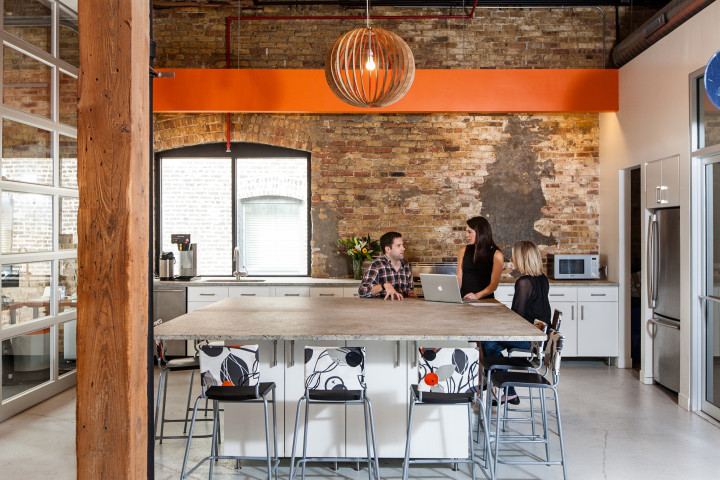Would you like to integrate more wellbeing into your day to day work life? Jamie Russo, the host of our webinar, “Winning with Wellbeing in the Workplace”, is here to help!

The kitchen at Enerspace Coworking in Chicago, where Jamie is chief of work and wellness. “I believe that the [office] kitchen is the one place that can foster all six aspects of wellbeing,” said Jamie. “Make it open, provide a large area for casually connecting – a large island or long, family-style table with stools is great for impromptu conversations.” Image courtesy of Enerspace.
[/cointent_lockedcontent]
2015 has seen an increased focus on wellbeing in the workplace, driven partly by the consumerization of office space. Those with the ability to choose where they work are placing their votes on spaces that are designed to support wellbeing. When they have the choice, people go where they can do their best work and be their best selves. As coworking spaces, coffee shops, and corporate offices compete for occupancy, how do you win with wellbeing?
Steelcase research has uncovered six dimensions of wellbeing that can be impacted by workplace design:
- Optimism: Fostering creativity and innovation
- Mindfulness: Fully engaged
- Authenticity: Really yourself
- Belonging: Connecting to others
- Meaning: A sense of purpose
- Vitality: Get-up-and-go
While the workspaces of the past may have been designed for efficiency, delivering on these dimensions calls for a new approach. Here are five attributes that can help you to win with wellbeing:
1. Support flexibility
Flexibility is related to a number of wellbeing dimensions and today’s employee makes it a priority. According to the 2015 Mobile Generations Orangebox Office Wars Report, 92 percent of millennials say “flexibility as a top priority when selecting a workplace.”
Additionaly, according to a recent Catalyst report, working women with MBAs showed that 32 percent of women with flexible work arrangements had reduced their career aspirations compared to 57 percent of those without.
Those with the ability to choose where they work are placing their votes on spaces that are designed to support wellbeing.
Allowing employees to have some flexibility around when and where they work is a key driver behind empowering them to be fully engaged and to be authentic – allowing people to prioritize work on a schedule that works for them.
2. Provide “choice architecture”
One of the most recent controversies in workplace design is the shift from private offices and cubicles to open-plan seating with the goal of reducing real estate footprints and improving collaboration. The backlash to this one-size-fits-all approach has led to a focus on “choice architecture” to support activity-based working.
Real estate footprints can still be reduced while providing settings that fit the type of work employees need to do at any given time – private phone rooms, huddle rooms for two or three person meetings, flexible lounge areas for casual interactions, and library settings to support focused, uninterrupted work.
3. Bring “home” to “work”
We see this trend in coworking spaces and startup space design, but it’s making its way into corporations, as well. We want the best of both worlds – to work in an environment that fully supports our technological needs (convenient power; WiFi), but that’s comfortable, as well.
One specific “home” environment that doesn’t often make its way into the corporate environment is the kitchen. I believe that the kitchen is the one place that can foster all six aspects of wellbeing. Make it open, provide a large area for casually connecting – a large island or long, family-style table with stools is great for impromptu conversations. And if possible, provide some DIY activities – pour-over coffee, snacks with light prep required – that will require people to linger, take a break from their activity and strike up a conversation with the other person in the kitchen. Coworking spaces often provide full-sized refrigerators to support those health-minded members that bring their own lunch. And some even provide stoves/ovens for community potluck lunches!
4. Have a culture of authenticity
A recent Harvard Business Review article indicated that people working in coworking spaces reported levels of thriving approaching an average of six on a seven point scale. According to the researchers, “This is at least a point higher than the average for employees who do their jobs in regular offices, and something so unheard of that we had to look at the data again.”
Ditch the business casual dress code.
What are some factors? People who work in coworking spaces don’t have to put on a “work persona” to fit in. They have more frequent opportunities to explain to people what they do, making them feel interesting. The authors hypothesized that meaning may also come from the opportunity to help others out which is common in coworking spaces given the diversity of types of workers.
A couple of ways that corporations can help people be their authentic selves include:
- Ditch the business casual dress code. There is no sea of blue button-down shirts in coworking spaces. Individuals dress to their preference, not to fit in.
- Organize your workplace by neighborhoods rather than by function. This will increase the likelihood of new “collisions” leading to new people meeting each other, sharing their roles and potentially finding ways to help the other out.
5. Do great coffee
What creates a sense of vitality and optimism like an amazing cup of joe? During a WORKTECH 15 New York conference panel in May (check out the Work Design recap here), the moderator asked Martha Clarkson, an experience designer at Microsoft, about what was instrumental in drawing employees to the corporate campus. Clarkson said, quite simply, it was their new coffee bar. In addition to carafe coffee, consider offering either a full-service coffee bar or pour-overs and DIY espresso drinks – this allows people to express their individual coffee tastes and nurtures a sense of belonging by having a casual conversation with a colleague.

